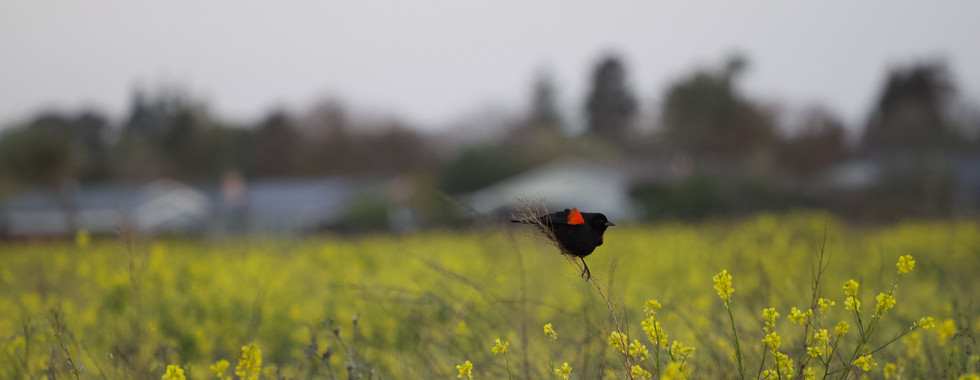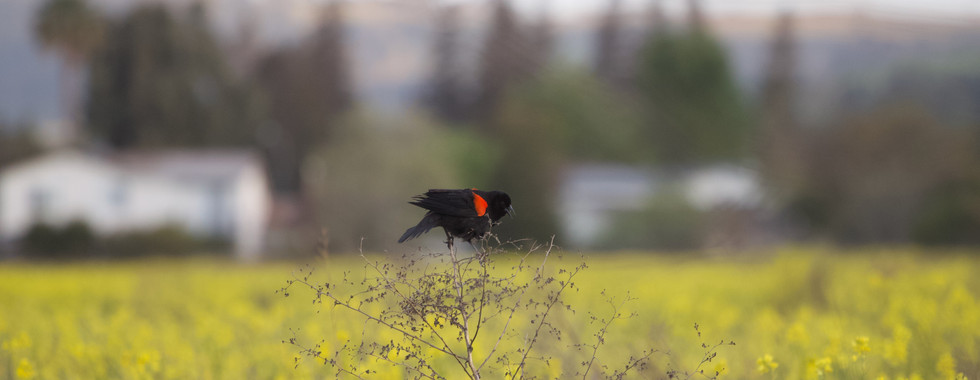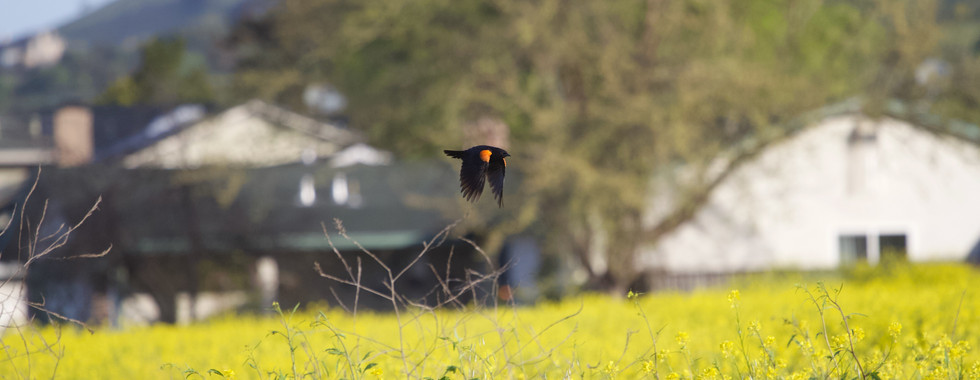Journal Entry: An Early Morning in a Mustard Field
- Sophia

- Apr 6, 2020
- 6 min read
Updated: Apr 7, 2020
On April 3rd, 2020, I got up before sunrise to photograph some blackbirds. Here's how it went.

All photos in this post were shot my me.
My alarm rung in my ears as I rolled over to turn it off. The sun hadn’t risen yet, but I could see a subtle blue glow behind the curtains. I hopped out into the cold air of my bedroom and got dressed as fast as I could, then gathered my nature journal, binoculars, satchel bag, and my moms camera that I had been borrowing. I climbed into my car for the first time in weeks and drove the short distance down the street to one of the many mustard fields in town.
Earlier that week, my younger sister and I rode our bikes to the same field to take some cute photos of ourselves. Springtime mustard fields are a popular site for photoshoots, and they really do live up to their reputation! For me, the enchantment of the place wasn’t just due to the mass amounts of beautiful lemon-yellow blooms, but also to the surprising amount of wildlife found there. Driving past at thirty or so mph, you would likely not notice how busy the place actually is. All around us as we took pictures, Red-winged Blackbirds (Agelaius phoeniceus) called and displayed and flew and quarreled. I hadn’t seen these confidant, spunky birds in a long time, so I knew I had to come back to spend some real quality time observing them. So that’s what I did.
But why did I wake up before sunrise? First of all, I've heard that wildlife is generally more active and birds are more vocal at the beginning of the day. It’s during this time that the birds are singing the world awake, welcoming the sun. I was also inspired to go out at sunrise by a podcast I started listening to a few weeks ago. It’s called Sound Escapes and it’s produced by BirdNote. The podcast is a collection of sound recordings done by the acoustic biologist, Gordon Hempton. (I love that job title!). Because he recently started to lose his hearing, he has been combing through his massive collection of recordings to share and present his life’s work. Many of the seven beautiful episodes are recordings of the dawn chorus, the sounds of the earth during the time surrounding sunrise, at different places on earth. That time of day is a favorite of Hempton’s, and I was so inspired by the beautiful ballet of sounds I heard on the podcast that I wanted to experience a dawn chorus of my own. So off to the field at sunrise I went.
As I drove up, a tall and graceful dear was crossing the street, clearly not expecting to cross paths with anyone. I slowed down to let her pass, then found a place to park close by the field. As I turned off the car and opened the door, my car was flooded with song. “Ov-er theeeeere!” The electric call of the redwing blackbird dominated the soundscape. I closed my eyes, took a deep breath of the cold morning air, then gathered my things, prepared for a morning in the field. I made sure to have the camera on and adjusted, because I knew the birds could give me “the shot” at any moment.
From where I parked, I couldn’t see the field; I could only hear the birds. But as I rounded the corner and cleared the small, artificial looking hill that lined the back of the field, both my eyes and ears were delighted. They were everywhere, and very lively. I wish I had half the energy of a Red-winged Blackbird in the morning! “Ov-er theeeeere! Ov-er theeeeere!” They called over and over, sometimes while perched, sometimes while in flight. Their pitch-black bodies and fiery-red shoulders stood out in stark contrast against the yellows and greens of the field. These elements combined made for a pretty stunning view, and hopefully some stunning photographs as well.

I walked along the edge of the field, knee-deep in frozen foliage. I had forgotten to check the temperature when I began, but I guess it must have been bellow freezing because after the sun had risen (when I remembered to check), it was around thirty-six degrees F°. Chilly! But that didn’t stop me, even though my fingers grew increasingly cold as the morning continued.
As I continued up and down the border of the field, I became slightly frustrated at not having yet gotten a good view of any birds. But once I finally stood still for a few moments, I realized that my constant movement was probably scaring them all away. In my silence and stillness, the birds began to perch closer and closer to me. It was so fascinating to watch them interact with each other. To my surprise, the males seemed to chase away the females quite often. Because it’s springtime, I figured that these birds might be trying to find a mate, so I was puzzled as this sort of interaction continued throughout the morning. What were the males trying to accomplish? Were the females being chased away because they had landed on a perch the males had claimed for themselves? As I pondered, another wonder caught my ear.

The songs that filled the field were fading away. A few moments of near-silence made me hesitate to make any noise myself. As I listened, I noticed the harsh, electric “ov-er theeeeere!” calls subtly shift to a smoother, more musical whistle, “dooown, dooown, dooown.” The high, soft, descending notes were quite different from the previous calls, which were harsh and buzzing. A single bird seemed to lead the way in this switch of songs. They all seemed to follow after him, soon calling in harmony with each other, each singing what their neighbor sang, but each neighbor possessing their own unique voice. It was a beautiful and mysterious experience. Were they communicating? Was it some sort of group warning system? Was it because of a herd (flock?) mentality? I’m not sure, but the experience definitely reminded me to pay extra attention to the birds vocalizations.
Though this synchronized song shift happened just once or twice while I was there, I began to notice the beautifully complex range of the Red-winged Blackbirds everywhere I walked. I heard whistles, toots, buzzes, and trills, among other sounds, come from single individuals. Sometimes the simplest looking birds have the most surprising voices.

It was getting increasingly more difficult to take clear pictures, because my hands were becoming more cold and numb. Regretting not brining gloves, I hesitantly decided that I should go back to my car and head home to warm up. But as I rounded the hill and came to the street where my car was parked, a saw another entrance to the field that looked promising. So I entirely ignored my previous decision and kept walking down the street. And I’m glad I did! I got some of the best shots of the morning on this side of the field. Because of this extra time, I continued to notice more wonderful things about the Red-winged Blackbirds, and I got a chance to further explore their vocalizations.

While listening and photographing from this new angle, I remembered a neat tool that John Muir Laws once shared on his blog post, "Sketch Bird Songs". Recalling the process he described, I first held my forefinger in the air and traced the “shape” of the song in the air as I heard it. Then, while still tracing, I tried to assign words to the song. Lastly, I whipped out my journal and a pencil and drew the shape that I had traced and wrote the words I assigned. I found that this was a fantastic way to not only record what I heard, but also to commit the song to memory. The next time a bird song catches your attention, I highly recommend giving this exercise a shot.
I lingered on this corner of the field for what must have been another half hour. From here, I noticed that the blackbirds seemed to prefer certain perches over others. Tall, grey, dry looking stalks stood tall above the already shoulder-high mustard blooms. Displaying birds would perch proudly on one of these stalks and call “ov-er theeeere!” while thrusting their shoulders forward to show off their red shoulder patches. Sometimes a group of birds would get in a fuss with each other and chase each other all around for a few moments. Once, I saw twenty or more birds explode up from the field in a loud and chaotic cloud, only to settle down quietly a few moments later.

After a few more photos, I finally wandered back towards my car. My hands were stiff with cold, so I had to sit in the running car for a few moments before driving back home. I looked over the field as I passes by, noticing the black specks darting back and forth between perches. It had been such a beautiful morning, and it was an incredible way to start the day. And for me now, Red-winged Blackbirds are more fascinating than ever before.

Here are a few more of my favorite shots from the morning.






















Comments